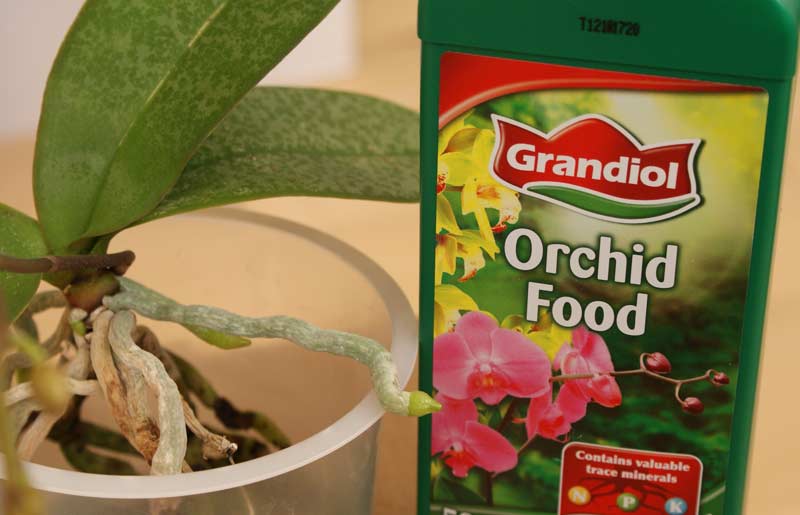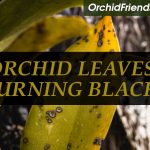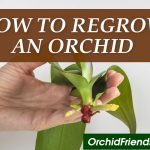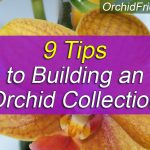
** This post is written and edited by a human being **
As I first discovered orchids, I never thought about fertilizing my plants. And whenever I started to investigate it, I was put off by the sheer complexity of it.
Let’s just put it like this; chemistry wasn’t my ‘thing’ at school – all the chemical formulas would only make my head spin! 😵
But as I got deeper into orchids, I thought maybe my plants could benefit from added fertilizer after all. Simply because even though my plants looked vibrant and healthy, it takes 1-2 years for an orchid to show signs of malnutrition.
To be on the safe side, I began to look into fertilizing again, doing my best to understand and simplify what/why/how/when to fertilize.
Since I am aware of how confusing this topic can be, I would like to pass on all the basics to get you started, while keeping it as simple as possible. We can get deeper into it another time, but let’s start with the birds and the bees.
So what should you feed your orchids? You can feed your orchids with balanced half-strength orchid fertilizer. Also, crushed eggshells, rice boiling water, banana peel water, Epsom salt, fish emulsion, kelp extract, and molasses can be used.
In nature, orchids absorb nutrients from their surrounding; bird droppings, decaying plant material, bark, and moss, etc., all provide essential nutrients and trace elements.
Once the orchids are removed from their natural habitat, they don’t have this natural flow of nutrients anymore. Even though organic potting media and even tap water contain some levels of nutrients, it’s not as much or as varied as it would be in nature.

Food for your orchids
When buying a balanced orchid fertilizer in the shop, the bottle shows three digits; e.g., 20-20-20. These numbers display (from left to right) the product’s nitrogen (N), phosphorus (P), and potassium (K) -ratio.
(N) Nitrogen – (P) Phosphorus – (K) Potassium
- Nitrogen promotes growth in the parts that are growing above the pot.
- Phosphorus promotes the growth and wellbeing of the parts that are inside the pot (root-growth but also the quality of the bloom).
- Potassium promotes your orchid’s overall wellbeing (helpful in cases of stressed plants)
The numbers are the percentages of each of these elements contained in the product. So 20-20-20 would provide 20% of each (N, P, and K).
This adds up to 60%, so the product’s remaining 40% contains other essential nutrients (micro- and macronutrients) orchids need.
The reason for the emphasized focus on the N-P-K is because they are needed in higher amounts.
If you’re new to fertilizing, it’s easiest to start with a balanced product like this because it fulfills your orchid’s all needs.
Of course, there are orchid fertilizers made explicitly for the growth or blooming period too, but if you want to keep it simple opt for the balanced one.
Things to keep in mind;
- Choose a fertilizer that contains no or very little urea
- Half-strength of the recommended dosage should always be used
- Introduce a new fertilizer (/fertilizing method) slowly, starting with only a few orchids before giving to all
- If you use tap water for watering and know it’s high in calcium, then added calcium in fertilizer is not needed
- If you detect any fertilizer salt build-up in the potting media (looks like small crystals), flush with clean water
How often should I feed my orchids?
There are plenty of different opinions on how often to feed orchids. One good way to plan the feeding schedule is to base it on the orchid’s behavior;
- Fertilize when your orchid is in the growth period
- Less when the growth is done (dormant period)
- Ease off or stop when the orchid is about to spike or bloom
That said, there is no one-rule-applies-to-all when it comes to fertilizing orchids.
Your environment, the type of water you use, the growing media, and the plants themselves can vary greatly – therefore you should experiment with what works the best for you.
Some orchid enthusiasts swear by “Weekly, weakly”, using only a quarter of the recommended dosage. Others don’t fertilize at all.
There are those who fertilize once in a blue moon, and those who fertilize every other week or once a month.
However, when using rain or distilled water, it’s a must to fertilize regularly as the water itself doesn’t contain any minerals.
TIP: Add a drop of fertilizer in water in a misting bottle. Mist on the orchid’s leaves and aerial roots. The more diluted the potion, the more often you can use it. Just make sure no water is left standing on the leaves for too long, so wipe off any excess water if your orchid room lacks a good airflow.
Should I feed my orchid while it is blooming?
There are mixed opinions about this. Some people advise not to fertilize at all while the orchid is in bloom, yet others continue to fertilize as usual. Some people simply reduce the given amount during this stage.
I’m still looking for a good explanation as to why it’s not a good idea to feed plants while they’re in bloom. Some might base it on the fact that the orchid appears to be on a dormant stage.
But I’ve witnessed many orchids growing new roots or leaves while in bloom, too. So until further notice; it’s up to you what you decide to do. There’s no right or wrong.
If you choose to keep fertilizing, then use the balanced orchid fertilizer mentioned above. Or you can use a bloom-specific fertilizer higher in phosphorus, which promotes flowering.

Can you use regular fertilizer on orchids?
The answer is; yes. If you compare ingredient lists of universal plant fertilizers and orchid fertilizers, you’ll discover they’re made of pretty much the same ingredients – just different amounts.
Because universal plant fertilizer is made for terrestrial plants (plants that grow in the ground), the amounts are stronger than what’s needed for orchids.
Epiphytic orchids (‘air plants’) absorb their nutrients directly and don’t need to absorb them from the media as terrestrial plants do. So to be on the safe side, use only half or even just a quarter of the recommended dosage.
Can I use orchid food on other plants?
Yes, you can use orchid fertilizer on other houseplants too. The strength compared to the universal plant fertilizer is weaker, but it will still have some effect.
Though keep in mind that universal plant fertilizer is more economical than orchid fertilizer, so you might want to stick with the cheaper option in the long-run when fertilizing many houseplants.
Can I feed my orchid Miracle-Grow?
Miracle-Grow is a plant food that most people have at least heard of. I have never tried it on my plants. However, it has the N-P-K ratio of 15-30-15, making it suitable also for orchids.
The higher P ratio promotes growth inside the pot; roots as well as the quality of blooming. So keep that in mind if you decide to feed Miracle-Grow to your orchids.
As mentioned above, when trying a new fertilizer, start with a low dose and only on 1–2 orchids first. See how they do on it before giving it to the rest of your orchids.
Can I use orchid fertilizer for roses?
The N-P-K needs for roses tend to be lower than for orchids. Popular N-P-K ratios for roses mentioned in rose fertilizer bottles are 10-10-10 and 12-12-12.
These might be much lower numbers than what your orchid fertilizer’s N-P-K ratio is. So check the numbers in your bottle – if they’re on the lower side, you can safely use the product for your roses.
But if they are on the higher side, use only half or even just a quarter of the recommended dosage. Remember it’s always better to under-fertilize than over-fertilize!
Can you use orchid mist on other plants?
You can use orchid mist on other houseplants too. I wouldn’t use it on plants like cactuses, but plants with green leaves are fine. Especially plants with thicker leaves that appear similar to orchid leaves.
‘Orchid mist’ is a bottle of water with added nutrients. They can also contain different types of plant oils, to give that ‘waxy’ look.
Ingredients vary from company to company. But generally speaking, they’re pretty safe to use, so if you have a bottle around, then go ahead and use it on your other plants too.
Conclusion
I hope this article about what to feed your orchid with, has helped you. It is a rather complex topic, and we could go even deeper into the chemistry of it. But it’s essential to avoid an overload of information because that would only lead to confusion. I’ve been there myself!
When it comes to orchid food, there is so much conflicting information out there – so it comes down to learning what can be done and how, and then choosing what fits you (and your orchids) the best.
That said, we covered the basic needs for feeding orchids, and what to look out for when selecting an orchid fertilizer.
Optionally, you can make your own fertilizer too. Please see HERE for DIY recipes!
Thank you for reading. Wishing you successful fertilizing, orchid friends!




